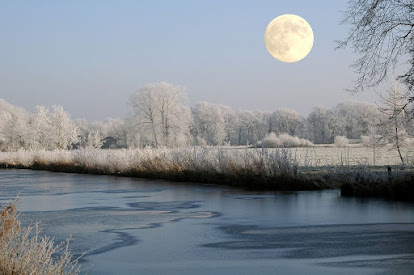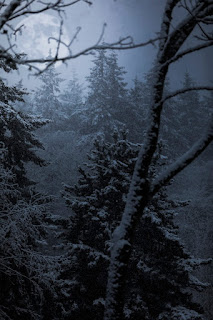This weekend we will be gifted with February’s full moon, known as the Snow Moon. For many of you out there, as you peer out the window at the snowscape that is your yard, the evocative nature of this name may not be all that appealing. But even for the snow-weary, this lunar event should produce some beautiful images and it gives us all an opportunity to consider gardening by the moon’s cycles.
It’s no secret that much of the US can expect snow in February, so the Snow Moon name is no surprise. It has been used by indigenous cultures for who-knows-how-many years. According to the Old Farmer’s Almanac, Captain Jonathan Carver visited the Naudowessie (Dakota) back in the 1760s and wrote that they called this time the Snow Moon, “because more snow commonly falls during this month than any other in the winter.” But other native peoples use different names. The Ojibe and Tlingit call it the Bear Moon and the Black Bear Moon respectively, because this is when bear cubs are born in their dens. Among the Mi’kmaq people in Eastern Canada, it is the Snow Blinding Moon due to the strong winds that accompany February snowstorms. Other tribes use names that speak for themselves: the Hunger Moon, the Little Famine Moon, and the Bony Moon. Here is a short video from the Old Father’s Almanac that tells you more about this cold moon and other moon lore.
Indigenous peoples did more than just give moons cool names, as far back as we know agriculture-based societies around the world have followed the phases of the moon to guide their farming practices. For thousands of years, Mayans have used their calendar system to track the movement of the moon and to plan when to plant and when to harvest their crops. Planting by the moon has long been a common practice throughout North America. As European settlers colonized the land, many settlers brought these ideas from their own ancient past and adapted to and adopted ideas from the New World. These practices are part of what we have come to know as traditional or heirloom farming.
Gardening by the moon is a fairly simple concept at its root. Simply put, the water in the soil is affected by the gravitational pull of the moon and plants respond to increased or decreased light of the moon. As the moon moves toward becoming a Full Moon, it is called a waxing moon. This phase brings the moisture in the soil closer to the surface. As it moves away from the Full Moon, it is in its waning phase, and soil moisture retreats from the surface. At the time of the Full Moon, the combination of the higher surface moisture in the soil and increased light from the moon makes it an optimal time to plant aboveground plants. As the light wanes and moisture moves down, the time is right to plant root crops. For more on this, check out this site. And the Old Father’s Almanac has a video on this as well
here.
here.
Many proponents of moon planting also take into consideration what sign of the zodiac the moon is moving through. The idea here is that since each sign of the zodiac is related to one of the four elements (Water, Air, Earth, and Fire), and these should be taken into consideration as well as the moon phase. According to this article, Air and Fire signs are barren and planting should never be done when the moon is in those signs (they also say never plant on Sundays, but I’m not clear where that comes from). Since each sign of the zodiac is also associated with a body part, some people may use terms related to said body parts when discussing this practice. Read this lady’s fun story for a better understanding of this.
Moon gardening has become somewhat of a thing lately for cannabis growers. As more people get into the game and they are all striving for the biggest, brightest buds, “new” techniques are eagerly embraced. More on that here. I’m sure there is lots of back and forth on the cannabis forums on this; I will leave it to you, dear reader, to go down that rabbit hole.
It needs to be said that not everyone is buying all this. No matter how long people have been doing it. This man brings up some excellent points, including climate change, planting zones, and the lack of substantive scientific research on the topic. No matter how you feel regarding planting by the moon (and especially if you are undecided), his article is interesting, informative, and worth reading.
Stay warm and take care.
Submitted by Pam











No comments:
Post a Comment